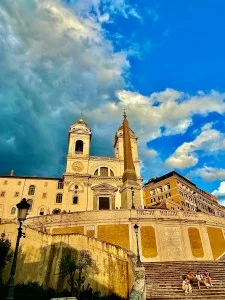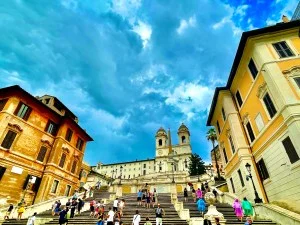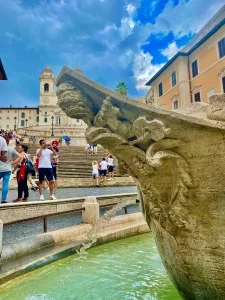Spanish Steps in Rome | Exclusive Private Tours of Rome | Customized Itineraries of Rome and the Vatican City

The Spanish Steps, a square steeped in history and the heart of old Papal Rome, derive their name from the Palace of the Spanish Ambassador, which majestically stands on the West side of the square.
Before the new part of the city was built, the English and American Quarter was surrounded by the best hotels. In the center is the ‘Barcaccia’ fountain, a historical masterpiece by Pietro Bernini, believed to commemorate the great flood of 1598. Opposite the fountain is the ‘Trinità dai Monti’ staircase, a grand structure built at the private expense of the French Ambassador Stephen Gouffier, who died in Rome in 1660, adding to the historical charm of the area.
It was begun with the architect Specchi and completed, under the reign of Benedict XII, by the architect De Sanctis in 1725. Up to a few years ago, on the steps, models dressed in fancy dresses and brilliant colors used to station to be hired by painters. The small obelisk in red granite at the top of the steps was erected by Pius VI in 1789, who found it buried among the ruins of the gardens of Sallust. On the right corner of the staircase, marked by an inscription, in the Memorial House of Shelly and Kids
The Memorial House of Shelly and Kids is where this latter poet lived during his residence in Rome and died on February 24th, 1821. The building was recently bought by a subscription made among the numerous admirers of the two great poets and is now used as a little memorial house. It contains a library and a little museum of souvenirs of the two great men—the guide of Rome.
The Spanish Steps in Rome. The famous English poet Sir John Keats lived and died on the Stairway. The Square of Trinità Dei Monti has a panorama over the whole lower part of Rome, and you can enjoy magnificent Roman sunsets. On the axis of the Stairway, the Sallustian Obelisk, an imitation of Egyptian obelisks, and the facade of the Church of Trinità Dei Monti, one of the leading French churches in Rome. Right, looking at the front, Via Gregoriana with the Palazzetto Zuccart and the Hertzian Library higher up. Via Sistina, formerly Via Felice, was opened by Sixtus V and is a favorite residence of XVIII and XIX Century foreign poets, artists, and intellectuals.


Spanish Steps in Rome | Exclusive Private Tours of Rome | Customized Itineraries of Rome and the Vatican City
The Church of Trinità Dei Monti, erected in 1495 by the initiative of King Charles VIII of France and consecrated one century after (1585) by Sixtus V, was restored by F. Marzois at the expense of King Louis XVIII. Attached is a Monastery and School of the Ladies of the Blessed Heart. The converging arm stairway to the Chuch is adorned with bas-reliefs, and two belfries flank the Baroque façade.
Interior: one-nave because the small side naves contain only chapels. Noteworthy: over the Main Altar is a fresco of the Virgin by T. and F. Zuccari; on the right is Assumption by Daniele da Volterra. of the Sodoma School. Left, a St. Joseph by Langlois, and Apparition by Giulio Romano. A Presepe (Nativity) Leaving the Church, we walk up the oak-lined Viale Della Trinità Dei Monti, which runs alongside the walls of the Convent and Villa Medici and leads us to a square with a fountain with water springing from a stone cannon bullet, and falling gracefully into a bowl. On the right are the French Academy entrance and the Villa Medici gates.
The Villa Medici was built in 1544 by A. Lippi for Cardinal Ricci. The Medicis took it over, then by the Grand Duchy of Tuscany, then by France; in 1803, they transferred to the Academy of Fine Arts founded by Louis XIV for the young French artists who wanted to perfect their skills in Rome. The severe simplicity of the outside facade contrasts with the monumental interior facade, which is believed to have been designed by Lippi with Michelangelo’s advice.
A portico supported by twin columns connects the two lateral wings. A rich decoration of statues, medallions, and bas-reliefs lends the movement of the various stories. The vast surrounding park is rich in trees, busts, and sculptures, including that of Meleagro (head) after the famous original by Scopas. On the side of the entrance to the Medici Villa, we enter the Pincio, the City park created by Valadier during the Napoleonic occupation (1809-14), with the vast panoramic square known worldwide for its splendid view and the spectacle of the Roman sunsets. The name probably comes from the Roman family.
Spanish Steps in Rome | Exclusive Private Tours of Rome | Customized Itineraries of Rome and the Vatican City

Rome city tours for groups or individuals!
Spanish Steps in Rome | Rome highlights | Vatican City Vatican Museum. Special offers to organize official private guided tours for individuals, large or small groups. A selection of the best tours of Rome and the Vatican includes skip-the-line tickets and exclusive entrances to Rome’s most important museums and art galleries. Please do not hesitate to contact us to book your tour or holiday in Rome. Rome Hotels in Trastevere.





